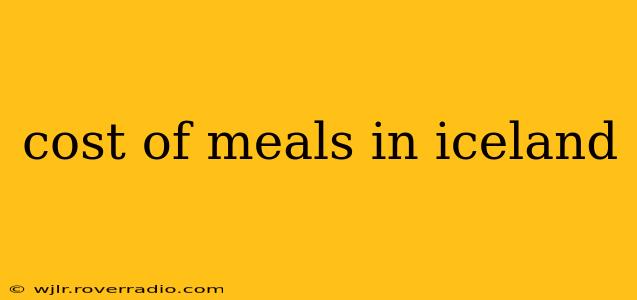Iceland, a land of fire and ice, offers breathtaking landscapes and unique cultural experiences. However, planning a trip to this Nordic island nation requires careful budgeting, especially when considering the cost of food. This comprehensive guide will delve into the various factors influencing meal prices in Iceland, offering insights into how to manage your food budget effectively during your visit.
What is the average cost of a meal in Iceland?
The average cost of a meal in Iceland varies significantly depending on several factors, including the type of restaurant, location, and the specific dishes ordered. A budget-friendly lunch at a local bakery or hot dog stand might cost around 1,500-3,000 ISK (approximately $10-$20 USD). However, a dinner at a mid-range restaurant could easily reach 5,000-10,000 ISK ($35-$70 USD) or more per person. Fine dining experiences can be considerably more expensive.
How much should I budget for food in Iceland per day?
A realistic daily food budget for Iceland depends on your eating habits and preferences. For budget travelers who are comfortable with self-catering using groceries from supermarkets like Bonus or Kronan, a daily budget of 5,000-8,000 ISK ($35-$55 USD) per person might suffice. This allows for some restaurant meals and snacks. However, if you plan on frequenting mid-range to fine-dining restaurants, you should expect to spend considerably more, potentially 15,000-25,000 ISK ($100-$175 USD) or more per day.
Are meals expensive in Iceland compared to other countries?
Yes, Iceland is generally considered more expensive than many other countries when it comes to food costs. This is due to several factors, including the island's geographic location, high import costs, and strong currency. However, it's important to remember that you can manage your expenses effectively by opting for budget-friendly options like supermarkets, street food, and happy hour deals at restaurants.
What are the cheapest places to eat in Iceland?
For the most budget-friendly meal options in Iceland, explore the following:
- Supermarkets: Stock up on groceries from supermarkets like Bonus and Kronan for breakfast, lunch, and snacks. This is the most cost-effective way to manage your food budget.
- Hot Dog Stands: Iceland's famous hot dogs are a delicious and affordable quick meal option.
- Bakeries: Grab pastries, sandwiches, and soups from local bakeries for a relatively inexpensive lunch or snack.
- Soup Restaurants: Many restaurants offer hearty and affordable soup options, perfect for a warm and filling meal.
- Happy Hour Deals: Check restaurant menus for happy hour deals, which often offer discounts on food and drinks during specific times.
What types of food are available in Iceland?
Icelandic cuisine offers a unique blend of traditional dishes and modern culinary innovations. Expect to find fresh seafood, lamb, and dairy products prominently featured on menus. Traditional dishes include:
- Skyr: A creamy dairy product similar to yogurt.
- Plokkfiskur: A fish stew.
- Hangikjöt: Smoked lamb.
- Kleinur: Sweet, twisted doughnuts.
How can I save money on food while traveling in Iceland?
To effectively save money on food during your Icelandic adventure, consider the following strategies:
- Self-catering: Prepare some of your own meals using groceries from supermarkets.
- Pack snacks: Bring snacks and drinks from home to avoid impulse purchases.
- Take advantage of free breakfast: Many hotels and guesthouses offer complimentary breakfast.
- Look for lunch specials: Many restaurants offer affordable lunch menus.
- Utilize public transportation: Avoid expensive taxi rides by using public transport, saving money that can be allocated to your food budget.
By carefully considering these factors and employing smart budgeting strategies, you can enjoy Iceland's culinary scene without breaking the bank. Remember to factor in your personal preferences and eating habits when planning your daily food budget. Happy travels!
